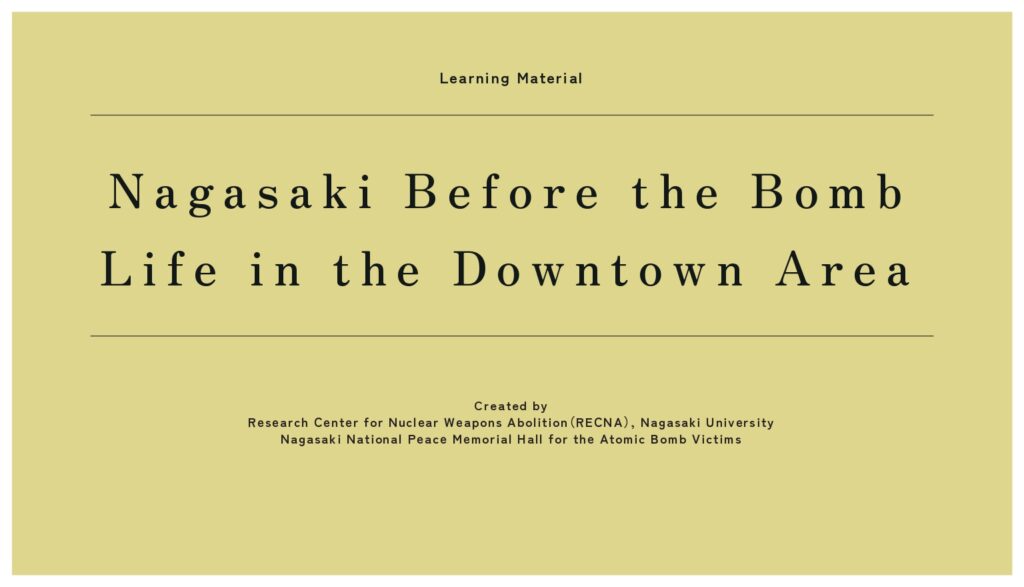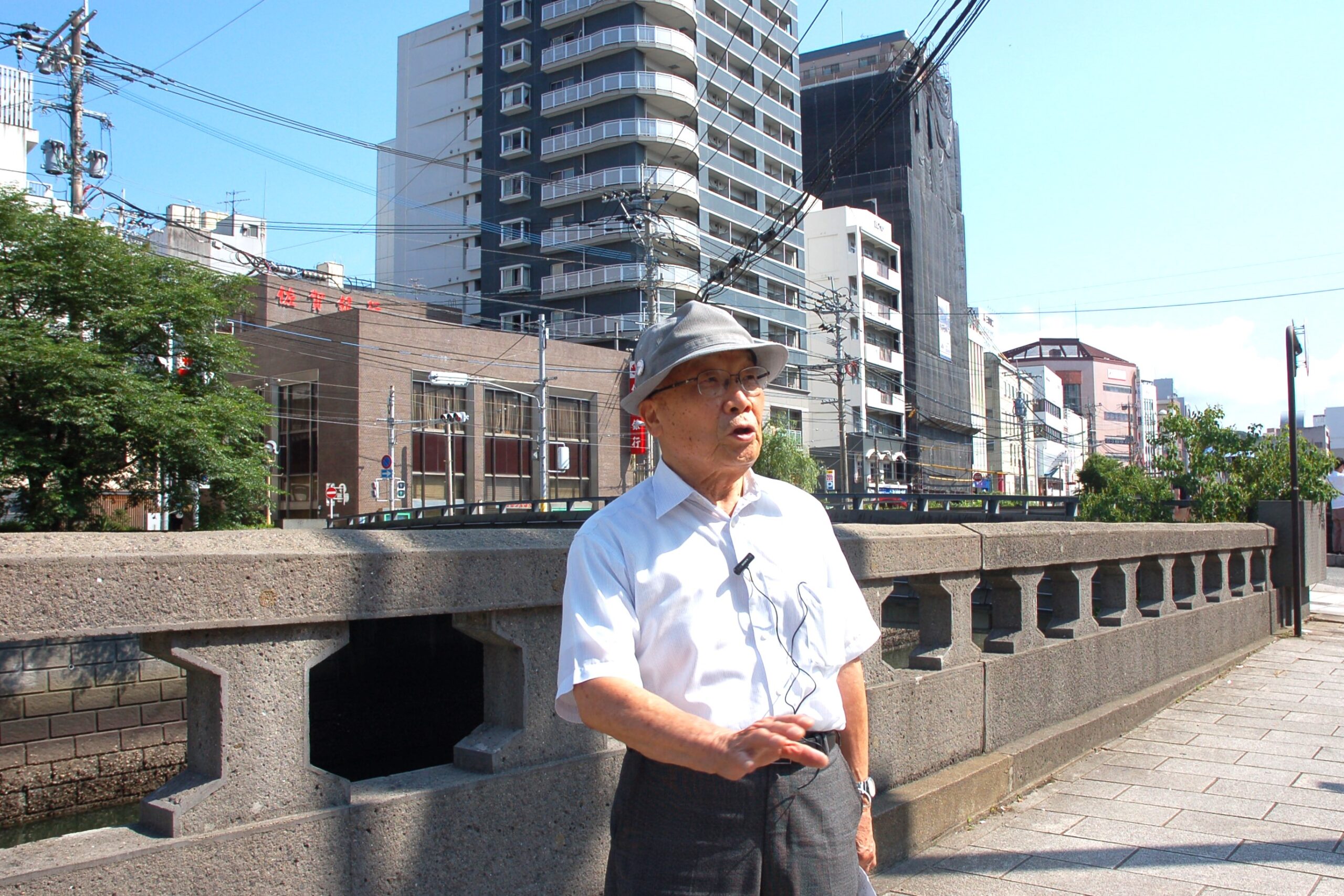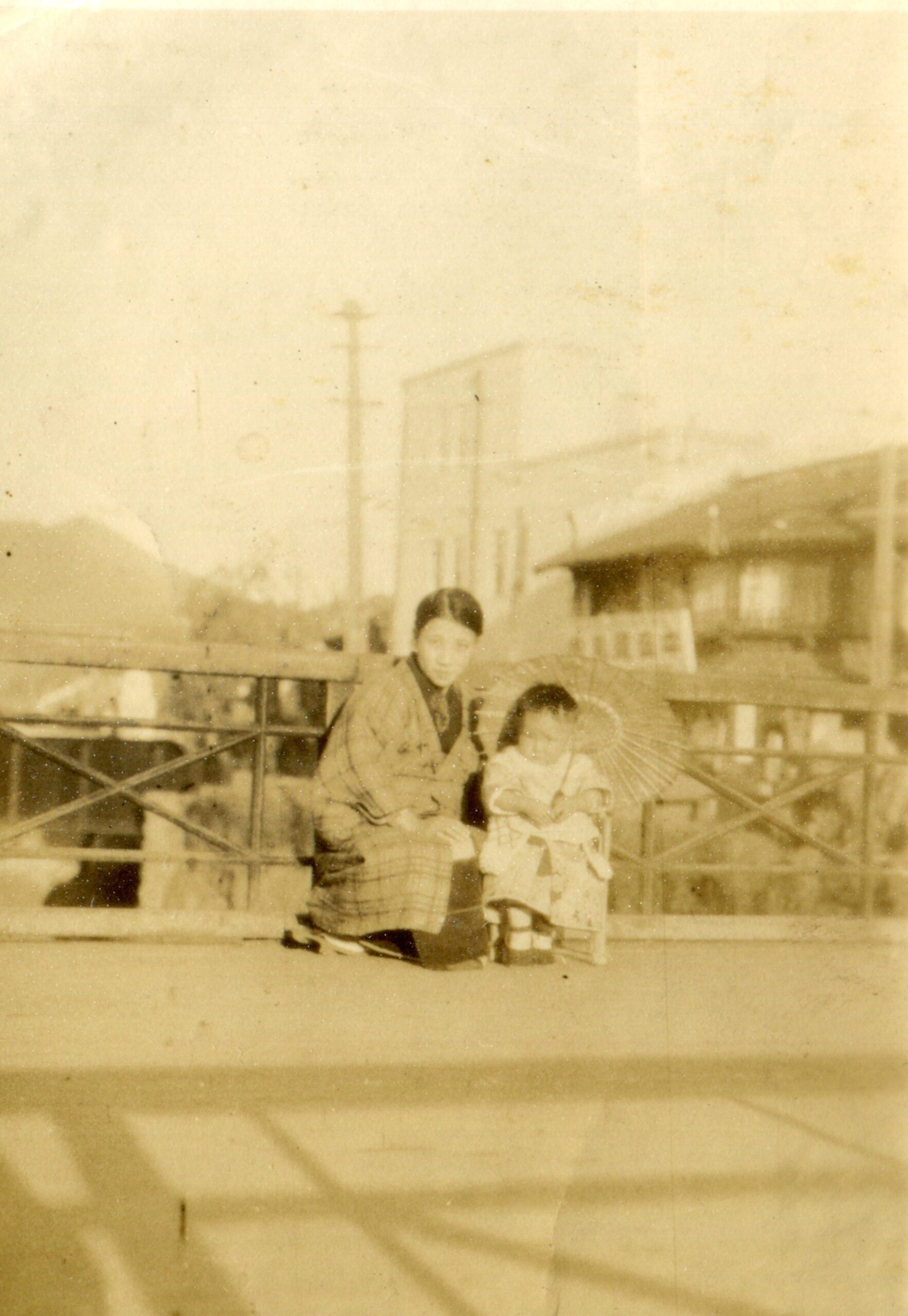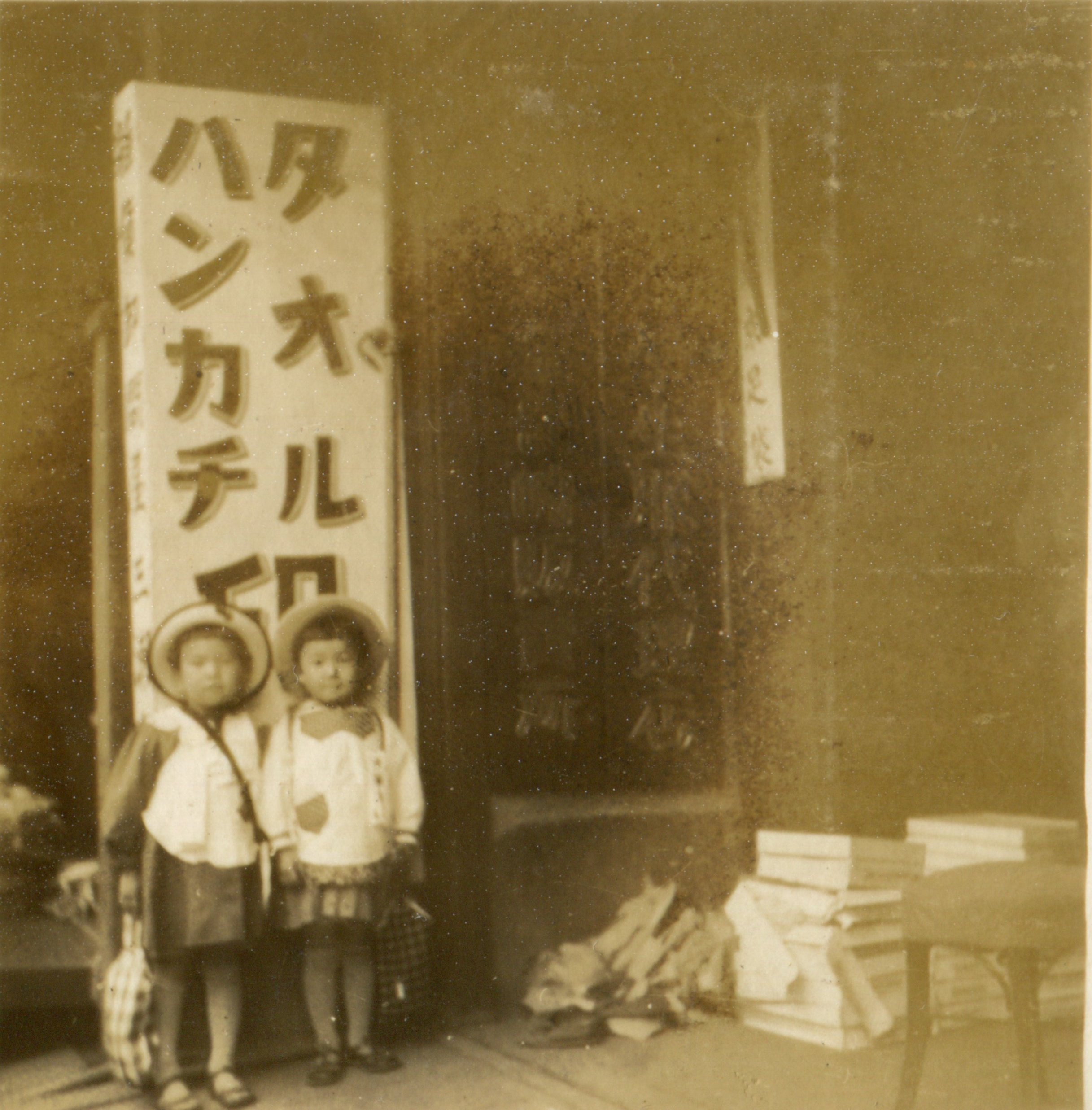
Nagasaki Before the Bomb Life in the Downtown Area
目次
Abstract
Nagasaki was the tenth most populous city in Japan at the time and was thriving. Its central downtown area was bustling with people, and life was affluent. However, with the onset of the Pacific War, people’s lives changed drastically as the war situation worsened. This section features a collection of photos and interviews with Seiichiro Mise, who was born and raised in “Mise Shoten,” a wholesaler of clothing, towels, and other goods in the downtown area since his grandfather’s time in the Meiji period. These materials highlight the life in downtown Nagasaki of those days.
Seiichiro Mise

Seiichiro Mise
Seiichiro was born in 1935. He was exposed to the atomic bombing at the age of 10 in Yanohira-cho, 3.6 kilometers from the hypocenter. At the time, he was a fifth grader at Irabayashi Elementary School. He lived with his grandmother, mother, brothers, and sisters—a total of eight people—while his father was away in the war. The house where he was born and raised in the center of the city (former Tsukimachi) had been removed due to the forced evacuation of buildings, and the family had just moved to their new location.
Mise Shoten
 Seiichiro standing at the former Tsukimachi 1 (now the Manbashi Bridge area), where he spent his childhood. Photo taken in June 2022.
Seiichiro standing at the former Tsukimachi 1 (now the Manbashi Bridge area), where he spent his childhood. Photo taken in June 2022.
“Mise Shoten was located right around where I am standing now. It was a wholesaler of towels, handkerchiefs, clothing, and other goods. The store, which also served as our home, was a three-story wooden structure. It had a basement, and I remember playing there a lot.”
The area where Seiichiro grew up was, and still is, the central downtown area of Nagasaki City. Back then, it was lined with the prefectural government buildings, police stations, courthouses, schools, banks, public markets, and stores.
 Taken around 1938 at Manbashi Bridge. His mother is on the left, and the one holding the parasol is his sister.
Taken around 1938 at Manbashi Bridge. His mother is on the left, and the one holding the parasol is his sister.
The Bustle of Nagasaki
 Taken around 1933 in front of Mise Shoten. The baby is Mise’s older sister, who was born the previous year.
Taken around 1933 in front of Mise Shoten. The baby is Mise’s older sister, who was born the previous year.
“It was a rare privilege just to own a camera at that time, but my father had a German-made one. That’s how well business was going back then. There were a lot of people and many stores around Tsukimachi, so the neighborhood itself was like a department store, where you could find everything.”
Signs, banners, and people passing by on the street capture the bustle of the shopping district. When Seiichiro was born in 1935, Nagasaki City’s population was approximately 210,000, according to that year’s national census. It was the second-largest city in Kyushu after Fukuoka City and the tenth largest city in Japan. Tsukimachi was the central area of Nagasaki, a vibrant and busy shopping district.
Business
 Taken around 1938 in front of Mise Shoten. His mother is on the left, and his sister is in front.
Taken around 1938 in front of Mise Shoten. His mother is on the left, and his sister is in front.
“The wooden box on the right side of the photo is what we would now call a cardboard box. Towels and other goods were delivered packed inside these boxes. To open the lid, we had to use a large key-like tool to remove the iron clasp. At that time, the store was overflowing with products, and there was a lot of merchandise.”
Mise Shoten was founded by Seiichiro’s grandfather in the former Tsukimachi as a wholesaler of clothing, towels, and handkerchiefs during the Meiji era. The store also wholesaled school uniforms and work uniforms. Today, it continues to operate as a wholesaler of towels and tenugui handkerchiefs in the central Edo-machi area, just as it did back then.
 Taken around 1938 in front of Mise Shoten. His sister is on his right.
Taken around 1938 in front of Mise Shoten. His sister is on his right.
Toys of the Time
 Taken in front of Mise Shoten around 1936-37. From left to right: his sister, Seiichiro, his grandmother, and his mother.
Taken in front of Mise Shoten around 1936-37. From left to right: his sister, Seiichiro, his grandmother, and his mother.
“I am the one on the horse-head four-wheeler. The one my sister is riding next to me was called a ‘skate’ at the time, which we now refer to as a kickboard. It was a trendy and fashionable toy back then.”
Seiichiro is the second of seven siblings. In the first half of the Showa Era (1926-1989), the country actively encouraged higher birth rates to increase the population for labor and military purposes. The slogan “Give birth, and you shall multiply” was even promoted, making a family of seven siblings not unusual at that time.
My Father and the Air Defense Group
 Taken around the 1930s at Suwa Shrine in Nagasaki City. His father is in the front row, fourth from the left.
Taken around the 1930s at Suwa Shrine in Nagasaki City. His father is in the front row, fourth from the left.
“The ‘Tsukimachi Security Guard Team’ was organized by my father and the neighborhood store owners. They wore matching uniforms and even made their own flags. My father, who was a soldier in Japan, led the group. Perhaps that’s why he has one more badge than the others.”
It is believed that this was an air defense group composed of local residents. The group was tasked with guarding, issuing warnings, and managing evacuation centers under military guidance in case of fires caused by air raids.
New Year’s Day
 Taken around 1939 at Yutoku Inari Shrine in Kashima, Saga Prefecture. Seiichiro is in the front row.
Taken around 1939 at Yutoku Inari Shrine in Kashima, Saga Prefecture. Seiichiro is in the front row.
“At New Year’s, we traveled to Yutoku Inari Shrine in Saga with all the employees and our family members to pray for business prosperity. Looking back now, the children are dressed in high-collar attire. It seems that both business and the social atmosphere were relatively relaxed at that time.”
Mise Shoten’s clientele was diverse, including not only those in Nagasaki City but also the surrounding coal mining areas. When the photo was taken, fashionable children’s clothing was available for those who could afford it, but supplies gradually became scarce. By 1940, the following year, the motto “luxury is the enemy” had emerged.
Elementary School
 Taken in 1941 at Shinkozen Elementary School. Seiichiro is in the front row, to the left of the female faculty member.
Taken in 1941 at Shinkozen Elementary School. Seiichiro is in the front row, to the left of the female faculty member.
“This is a picture of me when I started elementary school. There were 60 children in each class, which is equivalent to two classes today. The school was located in a downtown area, so many of us had parents who worked in the stores and public market. I used to visit the housing complex where people from the public market lived and played there.”
Shinkozen Elementary School, where Seiichiro began his education, had a total enrollment of about 1,700 students. However, after the war, the number of students declined, and the school was closed in 1997. The school building was used as a relief station immediately after the atomic bombing. Today, the site is home to the Nagasaki City Library, which features the “Shinkozen Memorial,” a reconstruction of the relief station’s scene.
Store Employees
 Taken at Mise Shoten around 1933-34.
Taken at Mise Shoten around 1933-34.
“These were the employees who worked at the store. They were like family and helped care for my siblings in place of our parents. Even though I was very young, I clearly remember how one of the employees would get angry with me, and another would send us vegetables from his family’s farm during the difficult times of the war.”
In 1940, rationing of daily necessities began due to the shortage of goods caused by the war, making it increasingly difficult for Mise Shoten to continue its business. As the war intensified, employees received military summons and left for combat. Some were never seen again amidst the postwar turmoil, but others maintained their connection with Mise Shoten, such as those who helped us during food shortages.
Forced Building Demolition
City center before the bombing, after forced building demolitions (photo by U.S. Army).
Courtesy of the Photographic Materials Research Committee, Nagasaki Foundation for the Promotion of Peace.
“At the end of the war, the government implemented a national policy of ‘forced building demolition.’ My town was also affected, and our store was demolished in June 1945. I had been temporarily evacuated to a relative’s house in Miyazaki Prefecture since that spring, but on August 1, I returned to the Yanohira-cho house where my family had relocated.”
Most buildings at that time were wooden, and fires spread quickly. To prevent the spread of damage from air raids, the government implemented “forced building demolition” to create open spaces (firebreaks). The targeted areas included those around public facilities, air-raid shelters, and densely populated residential neighborhoods. In Nagasaki City, approximately 610,000 square meters of land were affected, and around 25,000 families lost their homes.
August 9
 After the bombing, the Nagasaki Prefectural Government Office area seen from above the Nakajima River. Courtesy of Nagasaki Atomic Bomb Museum.
After the bombing, the Nagasaki Prefectural Government Office area seen from above the Nakajima River. Courtesy of Nagasaki Atomic Bomb Museum.
“On August 9, I was playing the organ at home when the bomb exploded at 11:02 a.m. Fortunately, my family and I were safe, but I lost seven relatives, including a cousin who lived near the hypocenter. If I had still been living in Tsukimachi that day, or if the sky over Nagasaki had been clear and the bomb had been dropped near Tokiwabashi Bridge, the initial target area, I might have lost my life.”
At center left is the prefectural government office and capitol building. From the center to the far right are houses in Kabashima-cho that escaped the fire. The Tsukimachi Public Wholesale Market is at the far right in the foreground. When the atomic bomb exploded on August 9, 1945, the mountains between this area and the hypocenter initially blocked the heat rays, so the fire did not start immediately. However, from midday to midnight on August 9, a fire broke out near the main prefectural office building and spread.
Message
When I was a child, life in the city was prosperous. Gradually, employees were drafted into the military, goods became unavailable, stores were demolished, and the atomic bombing claimed the lives of my cousin and others. After the war, we struggled to continue our business without supplies, and the difficult situation persisted. Through these photos, I hope visitors will gain a sense of the scenes and atmosphere of Nagasaki at that time, understand how they changed during the war, and appreciate the value of peace.
Learning Material “Nagasaki Before the Bomb: Life in the Downtown Area”
Created by Mitsuhiro Hayashida (RECNA Project Researcher), Ryo Sasaki (Writer)
Photographs provided by: Seiichiro Mise, Nagasaki Atomic Bomb Museum, Photographic Materials Research Committee, Nagasaki Foundation for the Promotion of Peace
Designed by Maika Okubo
Translation by Miho Tanaka
References and Websites
References
- Nagasaki Atomic Bomb Museum Edition. (2006). The Nagasaki Atomic Bomb Damage Records, Volumes 1, 2 and 3. Nagasaki City.
- Nagasaki Municipal Organization Centennial Chronological Table Compilation Committee Edition. (1989). Nagasaki Municipal Government Centennial Chronological Table. Nagasaki City.
- Nagasaki City Edition. (1939). 50 Years History of Nagasaki City System. Nagasaki City.
- Nagasaki Bunkensha. (1989). Nagasaki Jiten Sangyo Shakai Hen: Furusato no Kokoro wo Hiraku [Nagasaki Dictionary of Industrial Society: Opening the Heart of the Hometown]. Nagasaki Bunkensha.
- Hotei, Atsushi. (2020). Fukugen! Hibaku Chokuzen no Nagasaki: Genbaku de Kieta 1945 nen 8 gatsu 8 ka no Chizu [Restoration! Nagasaki just Before the Atomic Bombing: a Map of August 8, 1945, Lost in the Bomb]. Nagasaki Bunkensha.
Website
- 「被爆を語る 三瀬清一朗さん」GLOBAL NETWORK,https://www.global-peace.go.jp/picture/pic_syousai.php?gbID=767,(参照 2022-07-20)
- 「私の被爆ノート 真っ赤な太陽 不気味に」長崎新聞,https://www.nagasaki-np.co.jp/hibaku_note/3547/(参照 2022-07-20)
Learning Material
The slides can be viewed and used as teaching materials in educational settings. Download the PDF data from the bottom of the page. (Please observe the precautions noted on the slides before use.)
授業用補助資料
スライド教材と合わせて活用いただける補助資料はこちらから。

